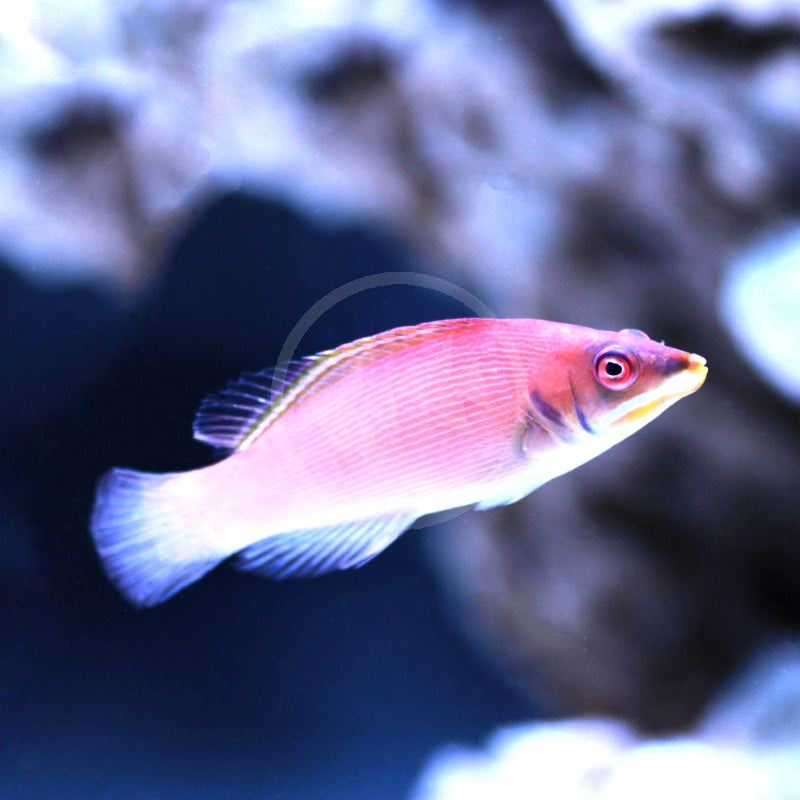Coral Farm Kuwait
scarlet pinstripe wrasse - Pseudocheilinus evanidus
scarlet pinstripe wrasse - Pseudocheilinus evanidus
Couldn't load pickup availability
Pseudocheilinus evanidus – سمكة الراس المخططة (Striated Wrasse)
تُعرف Pseudocheilinus evanidus أيضاً باسم الراس ذات الخطوط القرمزية (Scarlet Pinstripe Wrasse) أو الراس السرّية (Secretive Wrasse)، وهي سمكة بحرية صغيرة زاهية الألوان وذات طبيعة متحفظة. تُعد من الأسماك الشائعة المتوافقة مع الشعاب المرجانية في تجارة أسماك الزينة البحرية بفضل قوتها وجمال ألوانها.
الخصائص
-
التلوين: الجسم أحمر داكن إلى خمري مع حوالي 25 خطاً طويلاً باهتاً أبيض أو فاتح اللون. يوجد شريط أزرق شاحب أو أزرق مائل إلى الأبيض تحت كل عين.
-
الحجم: نوع صغير يصل طوله الأقصى إلى حوالي 3 – 3.5 بوصات (9 سم).
-
الاختلاف بين الجنسين: كلا الجنسين لهما نفس النمط تقريباً، لكن عادةً ما تكون ألوان الإناث أقل كثافة، بينما قد تكون خطوط وألوان الذكور أكثر وضوحاً.
-
الفلوريسانس: تُظهر سمكة الراس المخططة فلوريسانس حمراء على قشورها العظمية وأشعة زعانفها.
-
الشرنقة الليلية: مثل بعض أنواع الراس الأخرى، تُنتج شرنقة مخاطية لتنام فيها ليلاً، ويُعتقد أن ذلك يساعدها على تجنب المفترسات.
الموطن والسلوك
-
الانتشار الطبيعي: تتمتع هذه السمكة بانتشار واسع في منطقة المحيطين الهندي والهادئ، من البحر الأحمر حتى هاواي.
-
الموطن الطبيعي: توجد في الطبيعة في الشعاب المرجانية وبين الركام على المنحدرات المواجهة للبحر على أعماق تتراوح بين 6 أمتار وأكثر من 40 متراً. نادراً ما تُرى في المياه الضحلة.
-
الطبيعة المتحفظة: كما يوحي اسمها، هي سمكة خجولة ومتكتّمة بطبيعتها، وتفضّل البقاء بالقرب من الصخور والشعاب للحماية.
-
مكافحة الطفيليات: معروفة بنشاطها في اصطياد وأكل اللافقاريات الصغيرة غير المرغوب فيها في أحواض الشعاب المرجانية مثل قواقع الـ Pyramidellid، الديدان المسطحة، والديدان الشوكية.
العناية في الحوض
-
حجم الحوض الأدنى: يُوصى بحوض بسعة 55 جالوناً أو أكثر لتوفير مساحة كافية للبحث عن الغذاء وتحديد الإقليم.
-
البيئة: يجب أن يحتوي الحوض على الكثير من الصخور الحيّة مع كهوف وشقوق وفراغات لتختبئ فيها السمكة وتبحث عن الطعام. لا تحتاج إلى ركيزة رملية للحفر لأنها تنام في شرنقة مخاطية.
-
الغطاء: من الضروري وجود غطاء محكم لأن هذه السمكة معروفة بالقفز.
-
النظام الغذائي: كونها لاحمة، تتغذى بشكل أساسي على الأطعمة اللحمية. إلى جانب الإمداد المستمر من نظام الصخور الحية الناضج، يجب إطعامها روبيان الميسيس المجمد المدعّم بالفيتامينات، وروبيان البرين المجمد المدعّم بالفيتامينات، وكذلك رقائق وحبيبات بحرية عالية الجودة.
-
الطباع وزملاء الحوض:
-
هي بشكل عام مسالمة لكنها قد تكون شبه عدوانية، خاصة تجاه أسماك الراس الصغيرة الأخرى أو الأسماك المشابهة في الشكل التي تنافسها على مكانتها.
-
من الأفضل الاحتفاظ بواحدة فقط في الحوض إلا إذا كان الحوض كبيراً جداً مع كمية كافية من الصخور الحية لتأسيس أقاليم منفصلة.
-
يُستحسن إدخالها كآخر سمكة إلى الحوض لتقليل العدوانية تجاه أسماك الراس المسالمة الموجودة مسبقاً.
-
رغم كونها آمنة على الشعاب المرجانية في الغالب، قد تقضم أحياناً الجمبري الزخرفي الصغير أو المحار.
-
Characteristics
Coloration: The body is a deep red to maroon color with about 25 faint, fine, white or pale longitudinal stripes. A pale blue or bluish-white stripe is present under each eye.
Size: This species is small, growing to a maximum length of about 3 to 3.5 inches (9 cm).
Gender differences: Both males and females have similar patterns, but females typically have less intense coloration. Males may have more pronounced stripes and coloration.
Fluorescence: The striated wrasse exhibits red fluorescence on its bony scales and fin rays.
Nocturnal cocoon: Like some other wrasses, it produces a mucus cocoon to sleep in at night, which is thought to aid in avoiding predators.
Habitat and behavior
Natural range: The striated wrasse has a wide distribution across the Indo-Pacific region, from the Red Sea to Hawaii.
Wild habitat: In the wild, it is found in coral reefs and among rubble patches on seaward slopes at depths of 6 to over 40 meters. It is rarely found in shallower waters.
Secretive nature: As one of its names suggests, this fish is naturally secretive and shy, preferring to stay close to the protection of rockwork and coral.
Predator control: It is known for actively hunting and consuming small, unwanted invertebrates in a reef tank, such as pyramidellid snails, flatworms, and bristleworms.
Aquarium care
Minimum tank size: A 55-gallon or larger aquarium is recommended to provide ample room for foraging and territory.
Environment: The tank must have plenty of live rock with caves, cracks, and crevices for the wrasse to hide and hunt. A sand substrate is not necessary for burrowing, as they sleep in a mucus cocoon.
Lid: A tight-fitting lid is essential, as this species is a known jumper.
Diet: As a carnivore, the Pseudocheilinus evanidus primarily feeds on meaty foods. In addition to a constant food supply from a mature live rock system, it should be fed vitamin-enriched frozen mysis and brine shrimp, as well as high-quality marine flakes and pellets.
Temperament and tankmates:
It is generally peaceful but can be semi-aggressive, particularly towards other small wrasses or similar-shaped fish that compete for its niche.
It is best to keep only one per tank unless it is a very large aquarium with enough live rock to establish distinct territories.
It should ideally be the last fish introduced to the tank to minimize aggression towards existing peaceful wrasses.
While generally reef-safe, it may occasionally nip at small ornamental shrimp or clams.
Share


